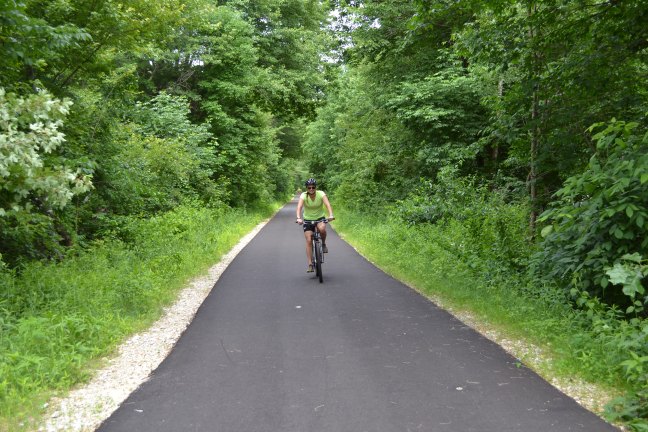Editor’s note: This “Taking to the Trails” column first appeared in The Londonderry Times newspaper.
By Paul Margolin, Londonderry Trailways
Sitting is not your friend. Harvard evolutionary biologist Daniel Lieberman reminds us of what we inherited from our hunter-gatherer ancestors: “We evolved to be athletes—you couldn’t survive without being active. We are genetically programmed to run around and eat modest amounts of food.” Unfortunately, many of today’s chronic diseases stem from a mismatch between our genes and our modern lifestyle of “too much sedentary behavior and too much food.”
In her 2020 book Exercise Is Medicine, nationally syndicated health columnist Judy Foreman lays out why a consistent program of physical activity is critical to our well-being. Several years in the making, her research references hundreds of studies that demonstrate how exercise helps ensure our fitness, ward off disease, and prolong our lives. Like most things in life, what you get depends on what you put into it. And when it comes to something as vital as personal health, it turns out that exercise is not optional.
The US Surgeon General first noted in 1915 that manual laborers suffered less degenerative heart, kidney and blood vessel problems than less active workers. Studies in 1922 and 1939 found that those in physically demanding jobs lived longer with less risk of cardiovascular disease than those at a desk and most white collar jobs. Similar studies in Scotland in the late 1940s determined that letter carriers who walked a route had superior heart health to stationary bus drivers and telephone operators.
Since 1948 the landmark Framingham Heart Study, which coined the term “risk factor,” has been monitoring the cardiovascular health of three generations of town residents. It has issued over 1,200 scientific papers and shown not just that exercise prevents heart disease, but that lack of exercise is a major risk factor for it.
The Bad News
In fact, the dangers of a sedentary lifestyle are eye-popping. The incidence of chronic disease, its severity, and the risk of dying from it are all increased. Sitting—whether its long hours working at a computer or watching TV–leads to increases in visceral fat. Says Foreman, “This is not an inert blob of tissue, but an active organ that pumps out chemicals leading to chronic system inflammation, insulin resistance, hardening of the arteries, and neurological degeneration.”
And that’s not all. A sedentary life is associated with high cholesterol levels, asthma, COPD, cancer, dementia, osteoarthritis, low back pain, frailty, constipation, muscle weakness, depression, and gallstones. Believe it or not, it accounts for as many deaths a year globally as smoking. “There’s no question that people who exercise more live longer and with less disability,” says Lieberman. “There’s nothing to debate. Removing exercise is like removing air: You get sick.”
The Good News
Who knew that working on a computer or watching TV is so risky? And what can we do about it? Well, it’s a relief to know that it’s all within our own power to exercise on a regular basis. Research has found that moving around for at least two minutes every hour mitigates the risks from long periods of sitting. Even just standing is preferable. Sitting after eating leads to a spike in blood sugar, but getting up and walking can cut those increases in half. And you’ll find it easier to regulate your appetite if you exercise regularly.
The World Health Organization’s guidelines recommend 150 minutes of moderate exercise weekly; that’s half an hour five times a week. Better yet, exercise vigorously and you can cut that to 75 minutes! Either a slow five minute run or a 15 minute walk is beneficial. But frequency and intensity both matter.
Generally speaking, the more active we are, the better our body and mind perform and the longer and more healthful our lives will be. The risk of a first heart attack has been found to be inversely related to how many calories a person burns per week in exercise; the more calories expended, the lower the risk.
Exercise Promotes Longevity
Exercise lowers the risk of heart disease, some cancers and all-cause mortality. It reduces blood pressure, fights diabetes, improves brain function and lessens inflammation. It also produces anti-oxidants, can improve vision, and may even reverse skin aging. In fact, research has found that people who don’t start exercising until their 60s can develop healthier hearts and improved mobility. Aging does not, inevitably, lead to poor health–but sitting does.
“It’s precisely because exercise acts on so many organs and bodily processes that it is so important,” says Foreman. It’s good to know that we have the power in our own hands–and feet, and lungs—to harness our body’s natural abilities and keep ourselves physically fit. Genes play a part, but our lifestyle choices—especially exercise—control 75% of our health and longevity.
So find ways to build a variety of exercise into your regular schedule. Hit the trail–whether it’s jogging on the Rail Trail, bike rides, rounds of golf (sorry, no cart), or regular walks in your neighborhood–and you will be fortifying your health.
For more information on fitness, check out Exercise is Medicine, and consult with your physician.

